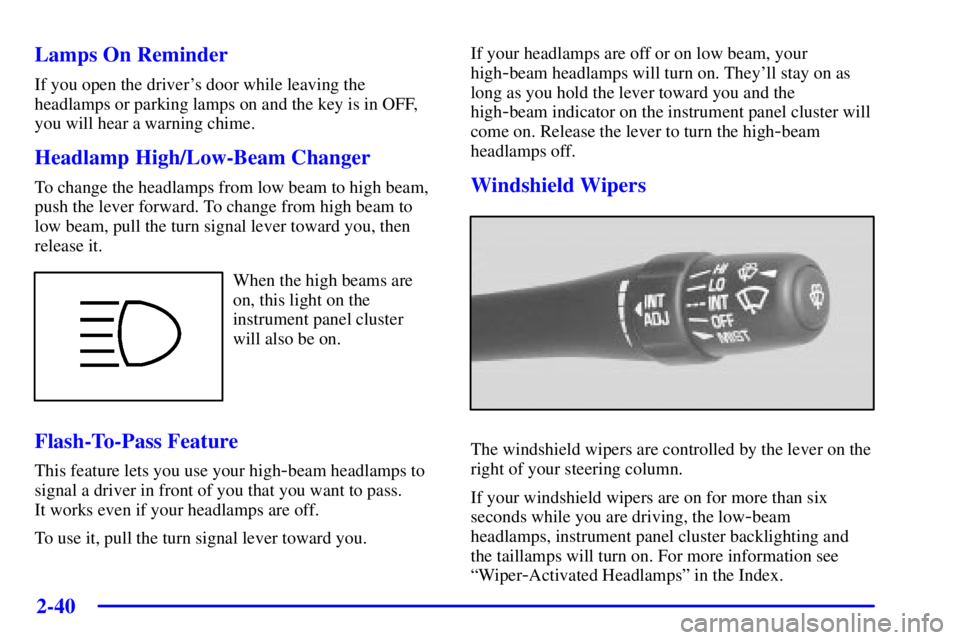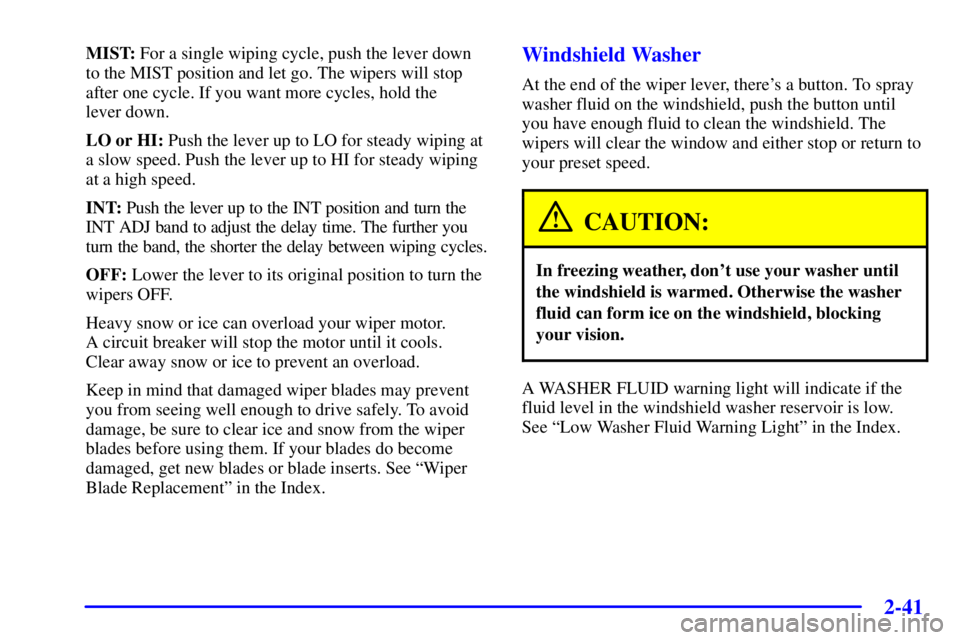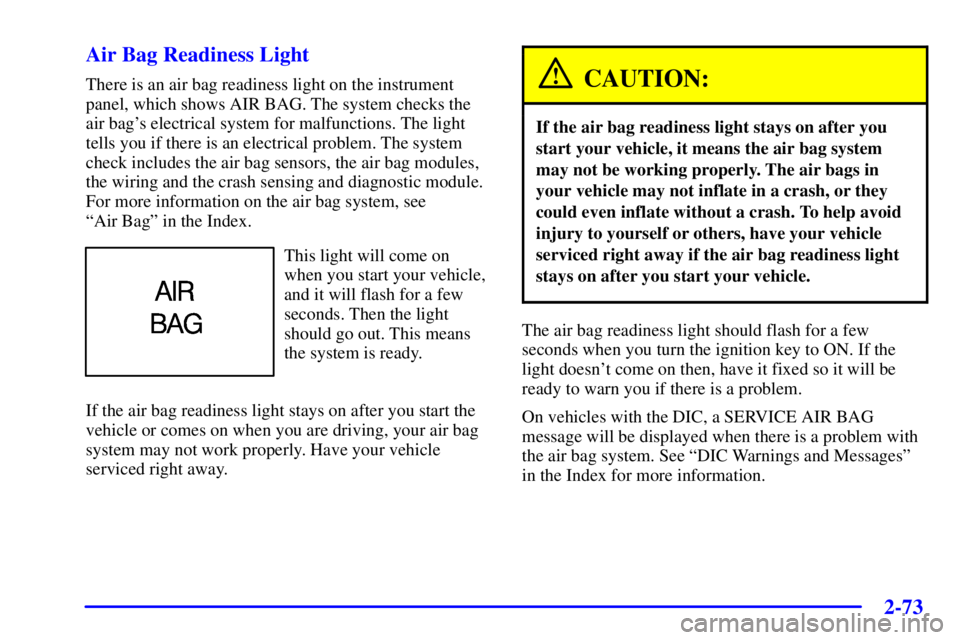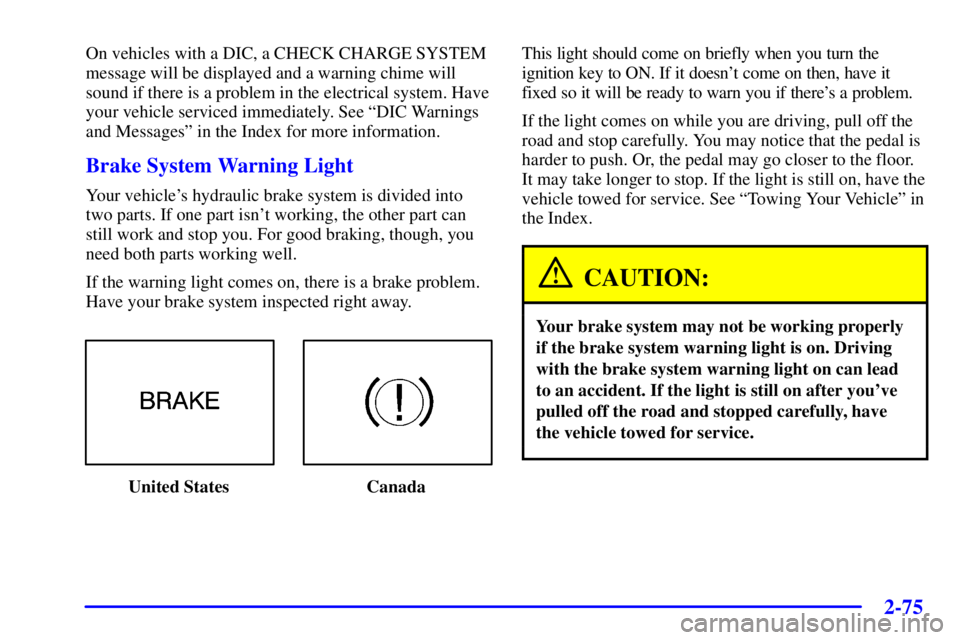Page 107 of 413

2-40
Lamps On Reminder
If you open the driver's door while leaving the
headlamps or parking lamps on and the key is in OFF,
you will hear a warning chime.
Headlamp High/Low-Beam Changer
To change the headlamps from low beam to high beam,
push the lever forward. To change from high beam to
low beam, pull the turn signal lever toward you, then
release it.
When the high beams are
on, this light on the
instrument panel cluster
will also be on.
Flash-To-Pass Feature
This feature lets you use your high-beam headlamps to
signal a driver in front of you that you want to pass.
It works even if your headlamps are off.
To use it, pull the turn signal lever toward you.If your headlamps are off or on low beam, your
high
-beam headlamps will turn on. They'll stay on as
long as you hold the lever toward you and the
high
-beam indicator on the instrument panel cluster will
come on. Release the lever to turn the high
-beam
headlamps off.
Windshield Wipers
The windshield wipers are controlled by the lever on the
right of your steering column.
If your windshield wipers are on for more than six
seconds while you are driving, the low
-beam
headlamps, instrument panel cluster backlighting and
the taillamps will turn on. For more information see
ªWiper
-Activated Headlampsº in the Index.
Page 108 of 413

2-41
MIST: For a single wiping cycle, push the lever down
to the MIST position and let go. The wipers will stop
after one cycle. If you want more cycles, hold the
lever down.
LO or HI: Push the lever up to LO for steady wiping at
a slow speed. Push the lever up to HI for steady wiping
at a high speed.
INT: Push the lever up to the INT position and turn the
INT ADJ band to adjust the delay time. The further you
turn the band, the shorter the delay between wiping cycles.
OFF: Lower the lever to its original position to turn the
wipers OFF.
Heavy snow or ice can overload your wiper motor.
A circuit breaker will stop the motor until it cools.
Clear away snow or ice to prevent an overload.
Keep in mind that damaged wiper blades may prevent
you from seeing well enough to drive safely. To avoid
damage, be sure to clear ice and snow from the wiper
blades before using them. If your blades do become
damaged, get new blades or blade inserts. See ªWiper
Blade Replacementº in the Index.Windshield Washer
At the end of the wiper lever, there's a button. To spray
washer fluid on the windshield, push the button until
you have enough fluid to clean the windshield. The
wipers will clear the window and either stop or return to
your preset speed.
CAUTION:
In freezing weather, don't use your washer until
the windshield is warmed. Otherwise the washer
fluid can form ice on the windshield, blocking
your vision.
A WASHER FLUID warning light will indicate if the
fluid level in the windshield washer reservoir is low.
See ªLow Washer Fluid Warning Lightº in the Index.
Page 134 of 413
2-67
The main components of your instrument panel are the following:
A. Air Outlets
B. Turn Signal/Multifunction Lever
C. Audio System Steering Wheel Controls
D. Windshield Wiper Lever
E. Steering Column Shift Lever
F. Driver Information Center (DIC) Controls
(If Equipped)G. Audio System
H. Hazard Warning Flashers Control
I. Twilight Sentinel
� and Fog Lamp Controls
J. Ignition Switch
K. Comfort Control System
L. Glove Box
Page 135 of 413
2-68
Instrument Panel Clusters
The instrument panel clusters are designed to let you know at a glance how your vehicle is running. You'll know how
fast you're going, how much fuel you're using, and many other things you'll need to drive safely and economically.
Your vehicle is equipped with one of these instrument panel clusters, which includes indicator warning lights and
gages that are explained on the following pages.
Standard Cluster (United States version shown, Canada similar)
Page 139 of 413

2-72
Warning Lights, Gages and Indicators
This part describes the warning lights and gages that
may be on your vehicle. The pictures will help you
locate them.
Warning lights and gages can signal that something is
wrong before it becomes serious enough to cause an
expensive repair or replacement. Paying attention to
your warning lights and gages could also save you or
others from injury.
Warning lights come on when there may be or is a
problem with one of your vehicle's functions. As you
will see in the details on the next few pages, some
warning lights come on briefly when you start the
engine just to let you know they're working. If you are
familiar with this section, you should not be alarmed
when this happens.
Gages can indicate when there may be or is a problem
with one of your vehicle's functions. Often gages and
warning lights work together to let you know when
there's a problem with your vehicle.
When one of the warning lights comes on and stays on
when you are driving, or when one of the gages shows
there may be a problem, check the section that tells you
what to do about it. Please follow this manual's advice. Waiting to do repairs
can be costly -- and even dangerous. So please get to
know your warning lights and gages. They're a big help.
Your vehicle may also have a Driver Information
Center (DIC) that works along with the warning lights
and gages. See ªDriver Information Centerº in
the Index.
The volume of your vehicle's warning chimes can be
adjusted. For more information see ªChime Level
Adjustmentº in the Index.
Safety Belt Reminder Light
When the key is turned to ON or START, a chime will
come on for about eight seconds to remind people to
fasten their safety belts.
The safety belt light will
also come on and stay on
for about 20 seconds, then
flash for about 55 seconds.
If the driver's belt is already buckled, the light will
come on briefly, but the chime will not sound.
Page 140 of 413

2-73 Air Bag Readiness Light
There is an air bag readiness light on the instrument
panel, which shows AIR BAG. The system checks the
air bag's electrical system for malfunctions. The light
tells you if there is an electrical problem. The system
check includes the air bag sensors, the air bag modules,
the wiring and the crash sensing and diagnostic module.
For more information on the air bag system, see
ªAir Bagº in the Index.
This light will come on
when you start your vehicle,
and it will flash for a few
seconds. Then the light
should go out. This means
the system is ready.
If the air bag readiness light stays on after you start the
vehicle or comes on when you are driving, your air bag
system may not work properly. Have your vehicle
serviced right away.
CAUTION:
If the air bag readiness light stays on after you
start your vehicle, it means the air bag system
may not be working properly. The air bags in
your vehicle may not inflate in a crash, or they
could even inflate without a crash. To help avoid
injury to yourself or others, have your vehicle
serviced right away if the air bag readiness light
stays on after you start your vehicle.
The air bag readiness light should flash for a few
seconds when you turn the ignition key to ON. If the
light doesn't come on then, have it fixed so it will be
ready to warn you if there is a problem.
On vehicles with the DIC, a SERVICE AIR BAG
message will be displayed when there is a problem with
the air bag system. See ªDIC Warnings and Messagesº
in the Index for more information.
Page 141 of 413

2-74
Battery Warning Light (If Equipped)
This light will come on
briefly when you start the
vehicle, as a check to show
you it is working; then it
should go out.
If it stays on, or comes on while you are driving, you may
have a problem with the electrical charging system. It could
indicate that you have a generator problem or another
electrical system problem. Have it checked right away.
Driving while this light is on could drain your battery.
If you must drive a short distance with the light on, be
certain to turn off all your accessories, such as the radio
and comfort control system.
Some instrument panel clusters with a voltmeter gage do
not have a battery warning light. They have a CHECK
GAGES warning to indicate a problem.
On vehicles with a DIC, a CHECK CHARGE SYSTEM
message will be displayed and a warning chime will
sound. See ªDIC Warnings and Messagesº in the
Index for more information.
Voltmeter (If Equipped)
You have a voltmeter
unless you have the
supercharged engine.
When the ignition is running, the gage shows the
condition of the charging system. Readings between the
red warning zones indicate the normal operating range.
Readings in the red warning zones indicate a possible
problem in the electrical system.
On vehicles with the systems monitor, the CHECK
GAGES light will also come on, and a warning chime
will sound if there is a problem in the electrical system.
Have your vehicle serviced immediately.
Page 142 of 413

2-75
On vehicles with a DIC, a CHECK CHARGE SYSTEM
message will be displayed and a warning chime will
sound if there is a problem in the electrical system. Have
your vehicle serviced immediately. See ªDIC Warnings
and Messagesº in the Index for more information.
Brake System Warning Light
Your vehicle's hydraulic brake system is divided into
two parts. If one part isn't working, the other part can
still work and stop you. For good braking, though, you
need both parts working well.
If the warning light comes on, there is a brake problem.
Have your brake system inspected right away.
United States CanadaThis light should come on briefly when you turn the
ignition key to ON. If it doesn't come on then, have it
fixed so it will be ready to warn you if there's a problem.
If the light comes on while you are driving, pull off the
road and stop carefully. You may notice that the pedal is
harder to push. Or, the pedal may go closer to the floor.
It may take longer to stop. If the light is still on, have the
vehicle towed for service. See ªTowing Your Vehicleº in
the Index.
CAUTION:
Your brake system may not be working properly
if the brake system warning light is on. Driving
with the brake system warning light on can lead
to an accident. If the light is still on after you've
pulled off the road and stopped carefully, have
the vehicle towed for service.